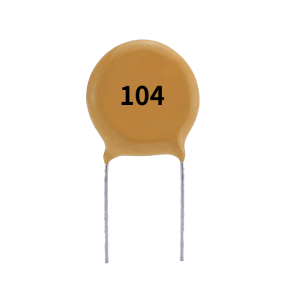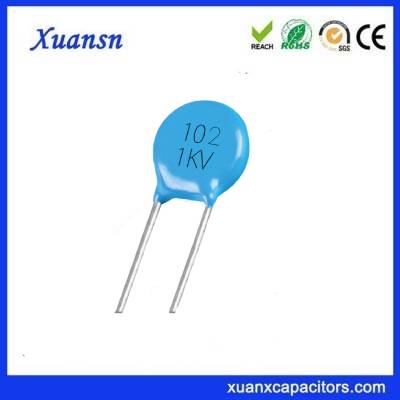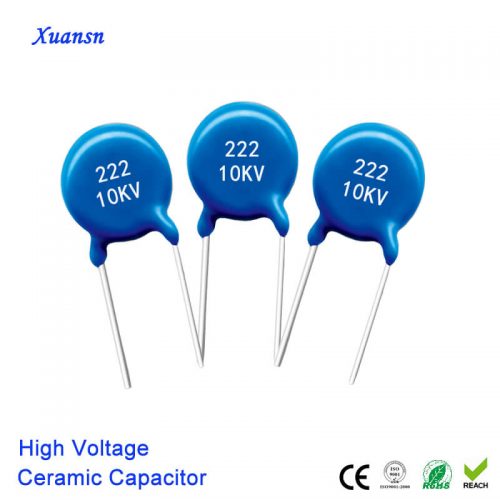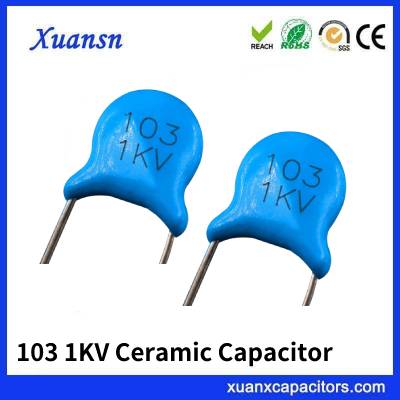- Power supply decoupling and filtering
- Timing and oscillator circuits
- Coupling and bypassing applications
- Signal conditioning and filtering
- RF (Radio Frequency) circuits
- High-speed digital circuits
104 Ceramic Capacitor 0.1UF 100NF Disc Radial CE RoHS Certification
Description
A ceramic capacitor is an electronic component that is widely used for its ability to store and release electrical energy. It belongs to the family of fixed-value capacitors and is constructed using ceramic materials as the dielectric. The dielectric material in a ceramic capacitor is typically made of ceramic compounds, such as barium titanate or titanium dioxide.104 Ceramic capacitor stands for a ceramic capacitor with a capacity of 100nf or 0.1uf.
Structure of 104 Ceramic capacitor
The structure of a 104 ceramic capacitor, also known as a 100nF ceramic capacitor, typically consists of the following components:
- Ceramic Dielectric: The dielectric material is the heart of the ceramic capacitor structure. It is usually made of a ceramic material, such as barium titanate (BaTiO3) or a combination of different ceramic materials. The dielectric material determines the capacitor’s electrical properties, such as its capacitance value and voltage rating.
- Metal Electrodes: The ceramic dielectric is sandwiched between two metal electrodes. The electrodes are typically made of materials like silver (Ag), palladium (Pd), or a combination of metals. The metal electrodes provide the means for electrical connections and allow for the storage and discharge of electric charge.
- Termination: Ceramic capacitors have termination points on each end that provide external connection points for the capacitor. The terminations are usually metalized areas on the ceramic body, which allow for easy soldering or surface mounting onto circuit boards.
- Ceramic Body: The ceramic body of the capacitor houses the dielectric material and the metal electrodes. It provides mechanical support and protection to the internal components. The ceramic body is often cylindrical or rectangular in shape, depending on the capacitor’s size and construction.
- Protective Coating: Some ceramic capacitors may have a protective coating or encapsulation to provide additional insulation and protection from environmental factors like moisture and contaminants. This coating helps ensure the long-term reliability and performance of the capacitor.
We take pride in utilizing high-quality materials and advanced manufacturing processes to ensure the performance and reliability of our capacitors. The compact size and simple construction of our ceramic capacitors make them highly suitable for various applications where space is limited and electrical performance is critical. Rest assured that our 104 ceramic capacitors are designed to meet the highest standards and deliver exceptional performance in your electronic projects.
Characteristics of 104 Ceramic Capacitor
Like other ceramic capacitors.104 ceramic capacitors share several common characteristics that make them widely used in electronic circuits. Here are some of the common characteristics of ceramic capacitors:
- Capacitance Range: Ceramic capacitors offer a wide range of capacitance values, ranging from a few picofarads (pF) to several microfarads (µF). This wide range allows for flexibility in selecting the appropriate capacitance value for specific circuit requirements.
- Voltage Rating: Ceramic capacitors are available in various voltage ratings, which indicate the maximum voltage the capacitor can withstand without experiencing electrical breakdown. Voltage ratings typically range from a few volts to several hundred volts, depending on the size and type of the capacitor.
- Compact Size: Ceramic capacitors are known for their small and compact size. They have a high capacitance density, meaning they can provide relatively high capacitance values in a small physical package. This compact size makes them suitable for applications where space is limited, such as in portable electronic devices or densely populated circuit boards.
- High Frequency Response: Ceramic capacitors exhibit excellent high-frequency characteristics. They have low parasitic inductance and low equivalent series resistance (ESR), allowing them to effectively filter out noise and maintain signal integrity at high frequencies. This characteristic makes ceramic capacitors suitable for applications in RF (Radio Frequency) and high-speed digital circuits.
- Low Equivalent Series Resistance (ESR): Ceramic capacitors typically have low ESR, which is the resistance associated with the capacitor’s internal components. Low ESR allows ceramic capacitors to respond quickly to changes in voltage and provide efficient energy storage and discharge.
- Temperature Stability: Ceramic capacitors generally exhibit good temperature stability over a wide temperature range. They can operate reliably in both high-temperature and low-temperature environments, making them suitable for various applications that experience temperature variations.
- Low Cost: Ceramic capacitors are generally cost-effective compared to other types of capacitors. Their simple construction, availability, and high production volumes contribute to their relatively low cost.
- RoHS Compliance: Most ceramic capacitors are RoHS (Restriction of Hazardous Substances) compliant, meaning they do not contain hazardous substances like lead, mercury, or cadmium. This compliance ensures environmental friendliness and safety in electronic designs.
Applications of 104 ceramic capacitor
- Power Filtering: The 104 Ceramic Capacitor effectively filters out high-frequency noise and interference, ensuring clean and stable power supply in various electronic devices.
- Coupling and Decoupling: It is ideal for coupling and decoupling applications, enabling efficient signal transmission and noise reduction.
- Timing Circuits: Our capacitors are well-suited for timing circuits and oscillator circuits, ensuring precise and stable frequency control.
- Circuit Protection: With their ability to absorb and suppress overvoltages and spikes, our capacitors serve as a protective element in circuit designs.
Custom Design and Samples:
We understand that every project has unique requirements. We offer custom design and manufacturing services to meet your specific needs. Whether you require a different capacitance value, voltage rating, or package type, our experienced team can assist you in designing the perfect capacitor for your application. Contact us for more information and to discuss your project requirements.
Quality Assurance and Compliance:
Our 104 ceramic capacitors are manufactured to the highest quality standards. We have implemented a robust quality control system to ensure consistent performance and reliability. Furthermore, our products comply with industry regulations, including the RoHS Directive, ensuring they are free from hazardous substances.
FAQs
What is the value of 104 ceramic capacitor?
The value of a 104 ceramic capacitor represents its capacitance in picofarads (pF). In the case of a 104 capacitor, the value is 10 followed by 4 zeros, which translates to 10,0000 picofarads or 100 nanofarads (nF).
What does a 104 ceramic capacitor do?
A 104 ceramic capacitor is used to store and release electrical energy in electronic circuits. It acts as a passive component that provides capacitance, which is the ability to store electric charge. Ceramic capacitors are commonly employed for decoupling, filtering, bypassing, and coupling applications in various electronic devices.
What is the value of 104 capacitor in volts?
The value of a 104 capacitor in volts refers to its voltage rating, indicating the maximum voltage that the capacitor can safely withstand. The voltage rating for a 104 capacitor can vary depending on the specific capacitor series and manufacturer. It is essential to select a capacitor with a voltage rating higher than the voltage in the circuit to ensure reliable operation.
Does 104 capacitor have polarity?
No, a 104 capacitor, like other ceramic capacitors, is typically non-polarized, which means it does not have a positive or negative terminal. These capacitors can be connected in any direction in a circuit without considering polarity, making them suitable for both AC and DC applications.
What is the value of 103 ceramic capacitor?
The value of a 103 ceramic capacitor represents its capacitance in picofarads (pF). In the case of a 103 capacitor, the value is 10 followed by 3 zeros, which translates to 1,0000 picofarads or 10 nanofarad (nF).
How do you read a ceramic capacitor value?
Ceramic capacitor values are typically indicated using a three-digit or four-digit alphanumeric code. The most common coding system uses three digits, where the first two digits represent significant figures and the third digit denotes the number of zeros to be added. For example, a capacitor labeled as “104” corresponds to 10 followed by 4 zeros, resulting in a capacitance value of 100,000 picofarads or 100 nanofarads (100nF). In a four-digit code, the first three digits represent the significant figures, and the fourth digit represents the multiplier.
Contact Us:
For further inquiries, pricing details, or technical support, please feel free to contact our dedicated team.
- Email: sales1@xuanxcapacitors.com
- Phone/WhatsApp: +86-18825879082
- Skype: Coco.PSH
- Website: https://capacitorsfilm.com




